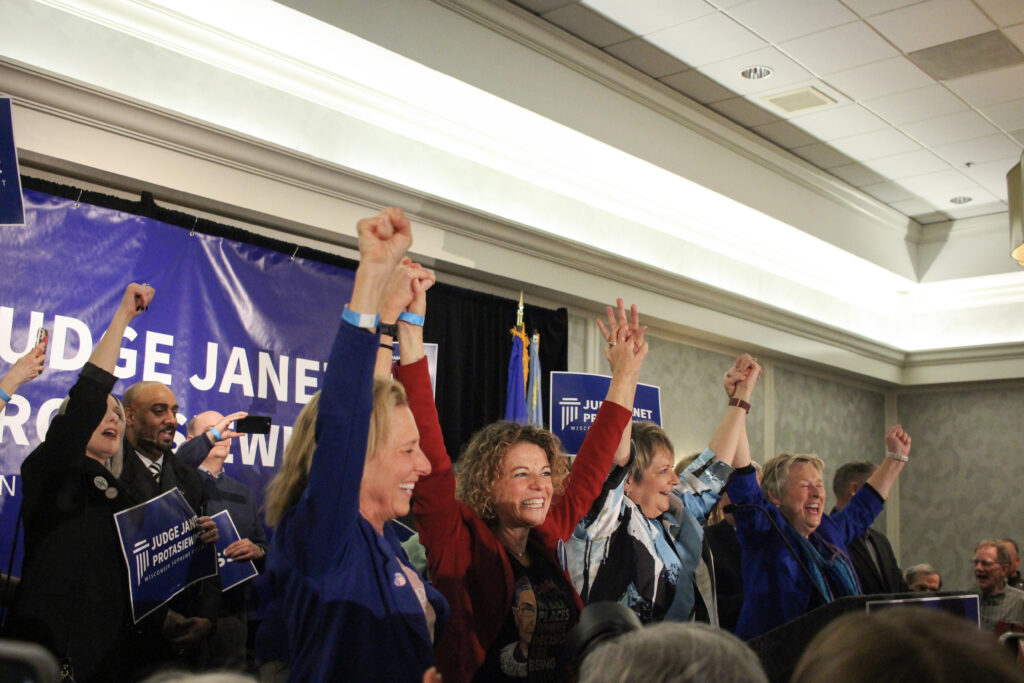This Is First Liberal Wisconsin Supreme Court In Living Memory
Media says court was liberal 15 years ago. Dead wrong. This is a radical change.

The soon-to-be four member majority on the Wisconsin Supreme Court, Jill Karofsky, Rebecca Dallet, newly elected Janet Protasiewicz and Ann Walsh Bradley. Photo by Henry Redman/Wisconsin Examiner.
On the day after Wisconsin’s nasty and expensive state Supreme Court election, the lead sentence of the Wisconsin State Journal’s front page election story proclaimed: “Milwaukee County Circuit Judge Janet Protasiewicz defeated conservative Dan Kelly for a seat on the Wisconsin Supreme Court Tuesday, giving liberals a court majority for the first time in 15 years, boosting Democrats’ bid to toss out Wisconsin’s near-complete abortion ban and promising to dramatically reshape politics in the battleground state.”
Wisconsin Public Radio, meanwhile, said this in its election-night report: “Democrats have scored a major off-year election victory in Wisconsin, winning the state’s open supreme court seat and flipping control of the court to liberals for the first time in 15 years.”
Both articles contain a contention that is highly questionable if not objectively false.
Protasiewicz did clobber Kelly by an unheard-of-for-Wisconsin 11-point margin. But in asserting that liberals controlled the Wisconsin Supreme Court as recently as 15 years ago, these news outlets were just repeating a shorthand description that became common during the election.
Here’s the headline and subhead of an ABC News story published on the morning of Feb. 19, the day of the primary election that narrowed the field to Kelly and Protasiewicz:
Democrats see a prime chance to take control of the Wisconsin Supreme Court
Democrats, who haven’t had a majority in 15 years, see concerns over abortion access and voting rights as key opportunities to take back control.
And two days before the election, NPR reported, “An election on Tuesday could change the political trajectory of Wisconsin, a perennial swing state, by flipping the ideological balance of the state Supreme Court for the first time in 15 years.”
Since the election, the idea that Wisconsin liberals have just gained a court majority for the first time in 15 years has continued to percolate.
Here’s The Capital Times in the lead sentence of a piece published April 6: “As Wisconsin’s state Supreme Court shifts toward its first liberal majority in 15 years, a liberal law firm plans to challenge the state’s voting maps based on the assertion that partisan gerrymandering violates the Wisconsin Constitution.”
And on April 13, the State Journal republished an editorial in the Kenosha News that said this “marks the first time the court will have a liberal bent in 15 years.”
It’s just not true
In fact, Wisconsin did not have what could be safely described as a liberal majority 15 years ago and quite possibly ever — if you count the many years in which “liberal” and “conservative” were not terms commonly applied to Supreme Court justices and contenders.
From 2004 to 2008, the court had three liberal justices, three conservatives, and one justice, Patrick Crooks, who was a swing vote. Yet while Crooks was appointed to a circuit court judgeship in Brown County by Wisconsin Gov. Martin Schreiber, a Democrat, he ran for election to the Supreme Court in 1995 as a conservative, losing in the general election to Ann Walsh Bradley. His campaign was run by Scott Jensen, a former Republican Speaker of the Wisconsin Assembly who would later end up being convicted of ethics violations.
Crooks was elected to the court the following year, beating Ralph Adam Fine, and was seen as a reliable conservative for much of his tenure, which ended when he died while still in office in 2015, after announcing that he would not seek reelection the following year. He was replaced by conservative Rebecca Bradley, appointed by Wisconsin Gov. Scott Walker and then elected to a full ten-year term in 2016.
In 2004, Crooks joined court liberals in a series of decisions seen as affecting businesses, drawing a hysterical reaction from the state’s big business lobby, which claimed that “America’s personal injury lawyers are racing to Wisconsin” to take advantage of these rulings, which the group said in an ad “send a clear signal to every CEO and top executive in the U.S. that Wisconsin will be a risky state in which to operate.” The ad showed a billboard that proclaimed, “Hello, Trial Lawyers! Good-bye Jobs!”
Yet despite this heated reaction, Crooks was still considered enough of a conservative that WMC sat back and let him get reelected without challenge in 2006.
It’s true that some people called him a liberal but that is far from firmly or clearly established. From his Wikipedia entry: “Crooks generally joined the conservative majority’s opinions, especially in criminal matters, but joined the liberal minority’s dissents on certain constitutional issues and matters of court administration.” In a 2011 Milwaukee Magazine article entitled “Crooks Is Not a Liberal,” journalist Bruce Murphy wrote:
“Yes, he is considered a liberal and is typically described that way in the media, but in fact, he’s a centrist who tends to lean right.” Murphy called the identification of Crooks as a liberal “the media’s error.”
An even bigger deal
Wisconsin Supreme Court watcher Alan Ball, a history professor at Marquette, has backed this up with numbers. In an analysis published a day after the election, he calculated that between 2004 and 2008, when Crooks was a critical swing vote, he “sided with the three liberals in 44% of non-unanimous decisions (Table 1)—considerably more often than the next closest “fourth man,” Justice David Prosser, who joined the three liberals in only 11% of non-unanimous decisions during this period.”
But still, Ball found, Crooks voted with the conservatives slightly more often than with the liberals. “Therefore,” he wrote, “it seems a stretch to describe the supreme court as ‘liberal’ during [this] period.”
So how long has it been that liberals comprised a majority on the Wisconsin Supreme Court?
“The court has never had a clear liberal majority in the decades that I’ve covered it,” Ball told me in an email last fall. “In the 21st century there have been years when it has ‘leaned’ conservative — when there have been three liberals (Abrahamson, AW Bradley, and Butler, for example, or, currently, AW Bradley, Dallet, and Karofsky) — and periods when it has been heavily conservative — most recently, the Gableman and Kelly years.”
“Thus, if a liberal prevails in next spring’s election, the court will be clearly liberal for the first time in living memory,” Ball wrote. “Given these stakes, I imagine that the upcoming race will completely shatter all spending records for judicial elections in Wisconsin.”
He got that right. The estimated $50 million that was sunk into the state’s Supreme Court race on behalf of the two candidates, in nearly equal measure, is five times the previous record for a Wisconsin Supreme Court race and more than three times the record for a judicial race anywhere in the United States.”
When Protasiewicz is sworn in this August, liberals will comprise a Wisconsin Supreme Court majority for the first time in at least four decades.
Just ask liberal Justice Ann Walsh Bradley, the court’s longest-tenured member.
“I’ve been on the court for twenty-eight years, and I’ve never served with what is labeled a liberal majority, one that sees the role of government and democracy the way that I do,” Bradley told journalist Dan Kaufman in an article published April 12 in The New Yorker.
In other words, despite all the advertising and national media attention, the issue of control of the court by liberals is an even bigger deal than what you’ve often been told.
Bill Lueders former editor of The Progressive magazine and current editor-at-large, is a Wisconsin writer who lives in Madison. He also serves as the elected president of the Wisconsin Freedom of Information Council, a statewide group that works to protect public access to government meetings and records.
Op-Ed
-
Unlocking Milwaukee’s Potential Through Smart Zoning Reform
 Jul 5th, 2024 by Ariam Kesete
Jul 5th, 2024 by Ariam Kesete
-
We Energies’ Natural Gas Plans Are A Mistake
 Jun 28th, 2024 by John Imes
Jun 28th, 2024 by John Imes
-
Milwaukee Needs New Kind of School Board
 Jun 26th, 2024 by Jordan Morales
Jun 26th, 2024 by Jordan Morales






















“Liberal” or “Conservative” Court? Those terms are too simplistic to describe a Court of seven justices. It is like portraying chess as tic-tac-toe. Good and fair justices make decisions based on their honest and objective view of the law and how it should work after an opinion is issued. A good justice does not consider iow some billionaire or politician wants the case to come out.
One reason our state supreme court was cited as authority and respected by state courts across the country – before Walker – was how the court reached its decisions. The facts were set forth fairly and evenly without bias. The opinion would show how the law had come into being and how it developed to the point it was before the court. The opinion would fairly discuss the strengths and weaknesses of each side’s arguments. The facts would be applied to the current law, a new modification of law if that was being asked for or perhaps a whole new branch off that “legal” tree. The majority would then state its rationale for applying the law, discuss why the other side’s arguments were not being adopted or applied and reach as decision. If a dissent was needed it would use logic to explain why the minority view was preferable and urge it be adopted in the future.
This was attractive to other state supreme courts for a number of key reasons. There were no false facts or facts simply made up to serve a purpose. A fair and balanced discussion of facts is the foundation of any opinion. The same applies to the discussion of where the law came from where it was that day and where it should go. It must be accurate, objective and fairly discuss the parties arguments on how it should be applied to he facts. Then our court would issue a decision based on how the majority found the law should be developed and applied. This is exactly what other state supreme court’s wanted and our court stopped doing. Providing an accurate description of the facts and law. That is an immense time savor. Instead of spending hours or days looking up the history and current position of that law, they had it and could focus on how it should be applied in their cases.
Under Walker our court drifted from all of these key factors. Opinions were filled with dubious facts, legal rules were not presented fairly, but twisted to favor the desired outcome and a specific outcome dictated the application of facts to law. Logic was replaced by rants that played to those with certain values. The opinions became cluttered and too long. Other courts saw this and found biased decisions based on a specific outcome and not logic, where worthless and they stopped using them. When we get back to that point we will have succeeded.
.
Cases at a supreme court often involve novel and complex issues. If the issues were easy to decide the case would not be at the supreme court. The next time you hear a supreme court candidate tell you they only “apply the law as written,” you will know they have no idea what they are talking about. What they mean is “I will apply the law as I want it to apply.” Most of what a supreme court does not involve silly slogans about applying the “rule of law.” There is no “rule” because something in the statute or case law is confusing trial court judges or is so vague or ambiguous that many reasonable people can differ on what it means. That is what they do and it is not easy and not subject to slogans that so many candidates love to toss out as if they really mean anything,
One more tidbit, contrary to the nonsense you heard in the campaign, Janet P is not soft on crime. She was a prosecutor for 25 years and a judge for eight. Anyone counting on her being a liberal on crimes issues needs to wake up. She is very tough on criminals but tempers it with a sound sense of justice. She may be a social liberal, but she is not liberal as to criminal law. Moderate is more accurate and at least half of the cases the court hears involve criminal laws.